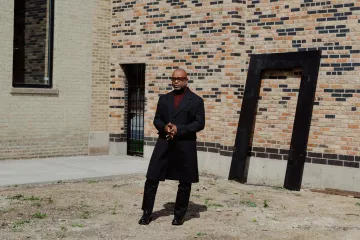Gates has exhibited and performed at Palais de Tokyo, Paris, France (2019) ; Sprengel Museum Hannover, Germany (2018); Kunstmuseum Basel, Switzerland (2018); National Gallery of Art, Washington D.C., USA (2017); Art Gallery of Ontario, Canada (2016); Fondazione Prada, Milan, Italy (2016); Whitechapel Gallery, London, UK (2013); Punta della Dogana, Venice, Italy (2013) and dOCUMENTA (13), Kassel, Germany (2012). He was the winner of the Artes Mundi 6 prize and was a recipient of the Légion d’Honneur in 2017. He was awarded the Nasher Prize for Sculpture 2018, as well as the Urban Land Institute, J.C. Nichols Prize for Visionaries in Urban Development.
Gates is a professor at the University of Chicago in the Department of Visual Arts and the College. Gates also serves as the Senior Advisor for Cultural Innovation and Advisor to the Dean. Gates is Director of Artists Initiatives at the Lunder Institute for American Art at Colby College Museum of Art and the 2018/2019 Artist-in-Residence at the Getty Research Institute (GRI).

Courtesy of Museum of Contemporary Art, Chicago, 2009.
Photo : Sara Pooley.
Theaster Gates:
Min | Mon
La Grande Halle
From
to
Celebrated for his profound art installations and conceptual works that challenge the borders between life and art, Theaster Gates is one of the most prolific artists working today.
Known for his expansive approach to space theory, sculpture, painting, film, and sound, Gates transforms the seemingly commonplace with a spirit of inquiry and imagination that defies limits and conventions. His work reorients and amplifies objects of historical importance, tackling a broad range of questions, such as the production of subjectivity, religion, identity, form, and materiality.
Min I Mon marks the beginning of a longer engagement between Gates and LUMA, during which multiple forms central to his ongoing explorations will manifest in LUMA’s spaces in Arles over a period of years. 民 (Min), meaning “people” in Japanese, and 門 (Mon), meaning “gate,” define the conviviality and cultural hybridity that are often at the heart of Gates’ historic projects.
At the center of the Grande Halle, Temple harnesses materials from Gates’ earliest exhibitions, transporting visitors to a site informed by what Gates terms “Afro-Mingei.” “Afro-Mingei” is the embodiment of an ongoing question that Gates examines regarding his own adjacency to non-American cultural legacies. For Gates, the Mingei movement extols the importance of excellent handmade craftsmanship made by and for everyday people. Espoused as propaganda fighting Western assimilation, Gates considers the legacies of Mingei alongside the Black is Beautiful movement, which challenged Eurocentric beauty standards in celebration of Black music, bodies, hair, and consciousness.
Temple, a sake bar and DJ booth, holds Gates’ personal archive of vinyl containing more than 2,500 albums of soul, funk, and R&B records. Uniting two key strands of his artistic interests, the structure houses an intimate yet public space that blends preexisting cultural conventions. MON—a new brand of sake produced by Gates in partnership with the Hakurou company—is crafted in Tokoname, Japan, the town where Gates studied ceramics. Offered publicly for the first time at LUMA, MON sake exemplifies Gates’ ongoing exploration of ritual and ceremony distinctive in Eastern culture and philosophy.
Lining the walls are prints with graphic interventions, such as Summer Tones for a Fall Situation and Kitsch Italian Design on the Backs of Blacks, highlighting the beauty and significance of the Black image. These studies are extracted from thousands of photographic prints from the image archive of Johnson Publishing Company, publisher of Ebony and Jet magazines, and aspire to keep alive one of the most important collections of Black culture of the twentieth century. Seeking to connect what might be at times distant realities, Gates supersedes the limitations of media working towards a redefinition of a spatial concept of art.
Gates’ sculptural practice and the ways in which he gives form to complex truths about labor, value, origin, and material, are made manifest in Sweet Chariot, Madonna in Pink, and The Grind. Min I Mon leads into what Theaster Gates expresses as a pathway where doors are voluntarily left open, where visitors might enter, stay, or leave. His intervention becomes passage in a space where the wind seems to sing and the objects to live.
Curated by Vassilis Oikonomopoulos, Director of Exhibitions and Programs and Chloé Bonnie More, Curator.
Screening hours
"Oh The Wind" is presented at the beginning of each hour, from 10:00 a.m. to 7:00 p.m.
Duration: 11min57s
"Art Histories" is screened after each broadcast of "Oh The Wind".
Duration: 41min39s
Theaster Gates
Theaster Gates lives and works in Chicago. Gates creates work that focuses on space theory and land development, sculpture and performance. Drawing on his interest and training in urban planning and preservation, Gates redeems spaces that have been left behind. Known for his recirculation of art-world capital, Gates creates work that focuses on the possibility of the “life within things.” Gates smartly upturns art values, land values, and human values. In all aspects of his work, he contends with the notion of Black space as a formal exercise – one defined by collective desire, artistic agency, and the tactics of a pragmatist.
